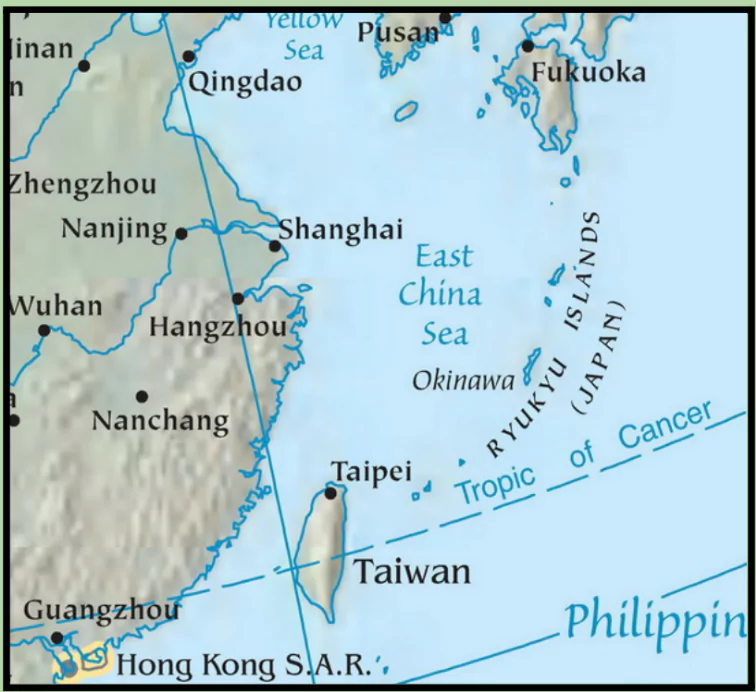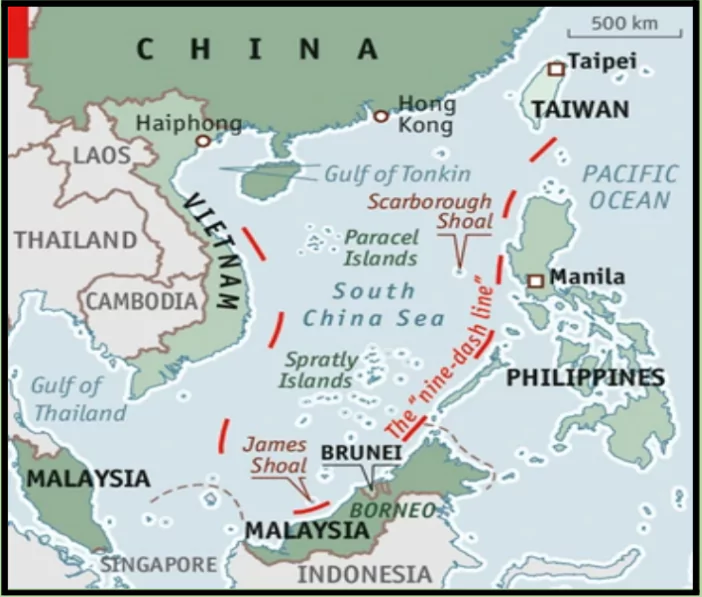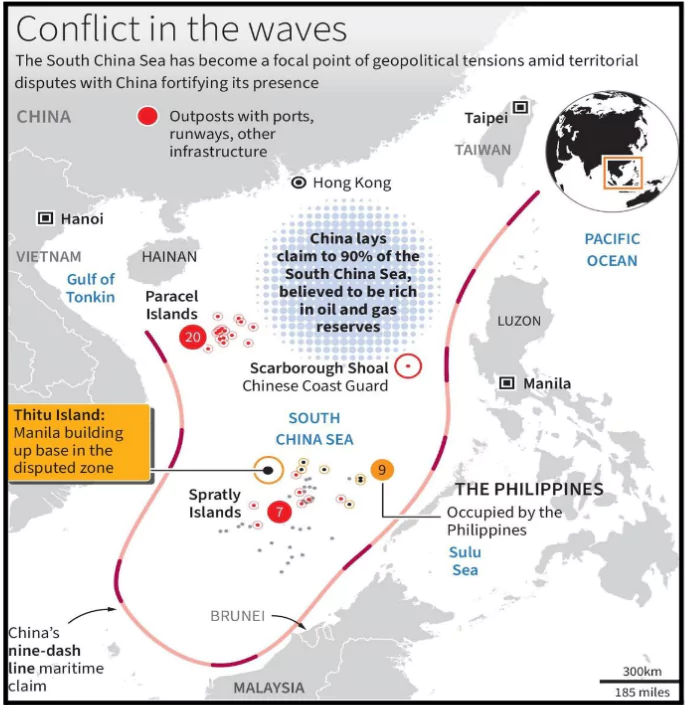Maritime East Asia has become a hotspot, with China pushing its claims over the Senkaku/Diaoyu islands and the South China Sea, raising tensions and reshaping the region’s power dynamics.

The East China Sea
- The East China Sea borders China, Taiwan, Japan, and South Korea.
- The East China Sea is primarily known for the territorial dispute between China and Japan over the Senkaku/Diaoyu Islands.
The South China Sea
- The South China Sea is bordered by China, Taiwan, and five Southeast Asian countries: Vietnam, Malaysia, Brunei, the Philippines, and Indonesia.
- It has become one of the most critical flashpoints in the Indo-Pacific due to overlapping territorial claims.
 The most notable dispute involves China’s extensive claims demarcated by the “nine-dash line,” which conflicts with the Exclusive Economic Zones (EEZs) of other nations The most notable dispute involves China’s extensive claims demarcated by the “nine-dash line,” which conflicts with the Exclusive Economic Zones (EEZs) of other nations
Significance of the East and South China Seas
- Strategic Maritime Trade Routes: Both seas are vital for global trade, with key maritime routes passing through them.
- The Taiwan Strait serves as a critical maritime choke point.
- Global Digital Economy: The region hosts important undersea cables essential for global communication and the digital economy.
- Energy Supply and Transport: In 2023, 10 billion barrels of petroleum and 6.7 trillion cubic feet of liquefied natural gas were transported through the South China Sea, highlighting its importance for energy supplies.
- Untapped Natural Resources: The seas hold vast reserves of untapped oil and natural gas, contributing to their strategic significance.
|
Enroll now for UPSC Online Course
Reasons For the Importance of the South China Sea (SCS) and East China Sea (ECS) to China
- Sovereignty and Territorial Integrity: China views the East and South China Seas as crucial to its sovereignty and national security.
- The 2019 Chinese Defence White Paper declares the South China Sea islands and Diaoyu islands as “inalienable parts” of its territory.
- Historical and Nationalistic Claims: The islands in these seas are considered part of China’s “lost territories,” with the nation striving to reclaim them as a symbol of its rise as a regional hegemon.
- National Security and Strategic Defense
- Historically vulnerable from the sea, China aims to secure its periphery by extending a ring of security around its maritime borders.
- The Diaoyu/Senkaku islands in the East China Sea (ECS) are seen as a defensive buffer against Japan and the U.S., allowing China to close security gaps.
- Control over these waters is crucial for defending against perceived threats from Japan, the U.S., and other regional powers.
- Natural Resources
- Both the SCS and ECS are rich in natural resources, including hydrocarbons (oil and natural gas) and marine life.
- The fishing industry, especially in the SCS, contributes to China’s economy and plays a vital role in global aquatic exports.
- Strategic Shipping and Trade Routes
- The South China Sea is one of the busiest shipping lanes in the world, connecting the Pacific and Indian Oceans.
- Control over vital sea lanes would enable China to safeguard its energy shipments and global trade while enhancing its maritime navigation capabilities and could also challenge U.S. naval presence in the Indo-Pacific region.
China’s Actions in the East and South China Seas

- Aggressive Territorial Claims: China is enhancing territorial claims by building military infrastructure and artificial islands while contesting regional nations’ claims. Examples:
- In the South China Sea (SCS), it builds infrastructure and deploys defensive systems on islands and reefs.
- Similarly, in the East China Sea (ECS), China conducts regular patrols around the Diaoyu Islands to reinforce its sovereignty claims.
- East China Sea Controversies: China has faced crisis with Japan, such as the 2010 fishing boat incident and the 2012 nationalisation of the Senkaku Islands, leading to heightened tensions.
- In 2023, Chinese Coast Guard activity around the Senkakus increased, indicating ongoing assertiveness.
- Escalation in the South China Sea: The South China Sea is a focal point for Chinese aggression, with the navy employing a Coast Guard and maritime militia using ‘grey zone’ tactics to alter the status quo without triggering outright war..
- Rising Tensions with the Philippines: The Second Thomas Shoal and Sabina Shoal have been the focus of China’s recent assertiveness.
- The Philippines’ resupply missions to the grounded ship, BRP Sierra Madre, have been repeatedly disrupted by China and have become a point of contention.
- Military Collaboration
- China conducted naval exercises with Russia in July 2024 to assert its influence, However, its claims in the South China Sea lack a legal basis, according to a permanent court of arbitration ruling in 2016.
- China has rejected that ruling.
Response from the Regional Countries
- Increased Defence Spending: Defence spending has increased across the Indo-Pacific with regional countries trying to catch up with China.
- For example, by 2027, Japan wants to double its defence expenditure.
- Philippines has acquired the anti-ship, BrahMos missiles from India.
- Active Pushback Against China
- Recently, the Philippines has shifted its strategy from minimising friction with China to actively publicising incidents of Chinese aggression.
- It is utilising public diplomacy tools, including documenting and sharing encounters with Chinese vessels on social media and involving international journalists in resupply missions.
- Strengthening Alliances with the U.S.
- The Philippines, Japan and South Korea are treaty allies of the U.S. and are strengthening their defence relationship with it.
- The United States, the Philippines, Australia, and Japan have formed a “Squad” for enhancing security and stability in the Indo-Pacific region.
- For the first time in history, the Defence Ministers of the United States, Japan and South Korea met in Japan in 2024.
- They strongly opposed any unilateral attempts to change the status quo in the waters of the Indo-Pacific.” and “stressed on respecting international law including the freedom of navigation and overflight.”
Check Out UPSC CSE Books From PW Store
Way Forward
- Upholding UNCLOS: Reinforce adherence to the United Nations Convention on the Law of the Sea (UNCLOS) and promote its role in resolving maritime disputes.
- Countries should collectively call for compliance with international rulings, such as the 2016 Permanent Court of Arbitration decision.
- Defense Alliances: Countries in the region should strengthen defence alliances and security partnerships, such as the Quad (U.S., India, Japan, Australia) and trilateral arrangements among the U.S., Japan, and South Korea, to deter aggressive actions.
- Multilateral Dialogues: Encourage multilateral dialogues involving China and Southeast Asian nations to address territorial disputes peacefully.
- Platforms like the ASEAN Regional Forum can facilitate discussions.
![]() 27 Sep 2024
27 Sep 2024


